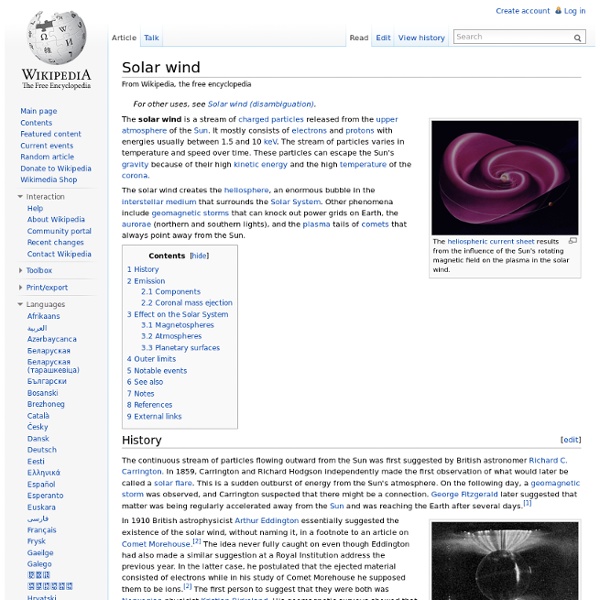Solar wind

Solar variation
One composite of solar variability between 1975 and 2005. Variations in total solar irradiance were too small to detect with technology available before the satellite era, although the small fraction in ultra-violet light has recently been found to vary significantly more than previously thought over the course of a solar cycle.[2] Total solar output is now measured to vary (over the last three 11-year sunspot cycles) by approximately 0.1%,[3][4][5] or about 1.3 Watts per square meter (W/m2) peak-to-trough from solar maximum to solar minimum during the 11-year sunspot cycle. The amount of solar radiation received at the outer limits of Earth's atmosphere averages 1366 W/m2.[1][6][7] There are no direct measurements of the longer-term variation, and interpretations of proxy measures of variations differ. History of study into solar variations[edit] Around 1900, researchers began to explore connections between solar variations and weather on Earth. Sunspots[edit] Solar cycles[edit]
Radiative forcing
Incoming solar radiation In climate science, radiative forcing or climate forcing, is defined as the difference of radiant energy (sunlight) received by the Earth and energy radiated back to space. Typically, radiative forcing is quantified at the tropopause in units of watts per square meter of the Earth's surface. A positive forcing (more incoming energy) warms the system, while negative forcing (more outgoing energy) cools it. Causes of radiative forcing include changes in insolation (incident solar radiation) and the concentrations of radiatively active gases, commonly known as greenhouse gases and aerosols. Radiation balance[edit] Atmospheric gases only absorb some wavelengths of energy but are transparent to others. Almost all of the energy which affects Earth's weather is received as radiant energy from the Sun. IPCC usage[edit] Radiative forcings, IPCC 2007. The IPCC AR4 report, defines radiative forcings as:[2] Climate sensitivity[edit] Example calculations[edit] Solar forcing[edit]
Solar radiation management
Removing trees from snowy landscapes can help reflect more sunlight into space[1] at latitudes that have meaningful incoming solar energy in the winter. A study by Lenton and Vaughan suggest that marine cloud brightening and stratospheric sulfate aerosols are each capable of reversing the warming effect of a doubling of the level of CO2 in the atmosphere (when compared to pre-industrial levels).[4] Background[edit] The phenomenon of global dimming is widely known, and is not necessarily a climate engineering technique. By intentionally changing the Earth's albedo, or reflectivity, scientists propose that we could reflect more heat back out into space, or intercept sunlight before it reaches the Earth through a literal shade built in space. These climate engineering projects have been proposed in order to reduce global warming. The applicability of many techniques listed here has not been comprehensively tested. Limitations[edit] Atmospheric projects[edit] Stratospheric aerosols[edit]
Extreme Weather, Climate Change
When it comes to connecting the dots between climate change, extreme weather and health, the lines are clear. The earth is saying something with record heat, drought, storms and fire. Scientists are telling us this is what global warming looks like. It's time to listen – and take action. There's plenty we can do. Carbon pollution is the main reason our planet is getting hotter, increasing the chances of weather disasters, drought and flood and hurting our health. There are solutions. But first, we need national leadership that will stop ignoring what the earth and scientists are telling us about climate change -- and instead start ignoring those who continue to deny it is happening. Here's what the first six months of 2012 brought: Unfortunately, the first half of 2012 is not the exception. The extreme weather of 2012 has already caused billions of dollars worth of damage, but again, that's just part of the trend. There are solutions to address extreme weather tied to climate change.
Related:
Related:



